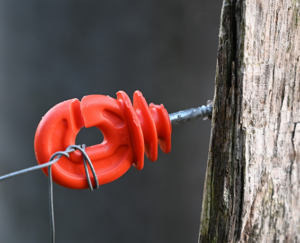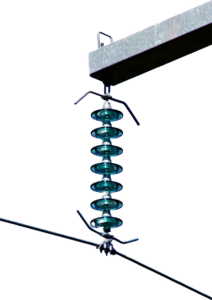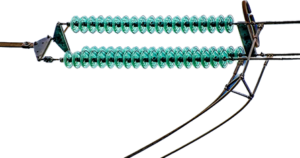Your end-fed wire antenna will have a very high voltage at the far end. A dipole will have high voltage at the end of each leg. High voltage will always be present at the end of a wire antenna.  Bearing this in mind, tying the end of the wire to a tree branch, without an insulator, could easily result in the tree catching fire! Not to mention the losses caused by direct contact of the wire with the tree. A friend of mine once set fire to the curtains in his bedroom. He had a voltage fed wire which brushed against the curtains as it passed through the open window. Not a good idea! There’s more information about voltage and current fed aerials here.
Bearing this in mind, tying the end of the wire to a tree branch, without an insulator, could easily result in the tree catching fire! Not to mention the losses caused by direct contact of the wire with the tree. A friend of mine once set fire to the curtains in his bedroom. He had a voltage fed wire which brushed against the curtains as it passed through the open window. Not a good idea! There’s more information about voltage and current fed aerials here.
The electric fence insulator shown here is suitable for a wire antenna, probably up to 100 Watts or more. They are cheap enough and very easy to install. You could screw it into a tree or, if you drill a small hole first, into the top of an aluminium pole.
 Some insulators can be costly, such a glass Pyrex types. They are excellent but, are they really necessary for transmitters up to 100 Watts or so? Ideally, yes. But there are other options, such as the electric fence insulator, especially if you are just starting out with the hobby and have limited funds. I use cable ties. Two or three strung together to form a chain makes an ideal insulator. Not at all professional, I know. But, do I care? The idea works so I’m fine with it.
Some insulators can be costly, such a glass Pyrex types. They are excellent but, are they really necessary for transmitters up to 100 Watts or so? Ideally, yes. But there are other options, such as the electric fence insulator, especially if you are just starting out with the hobby and have limited funds. I use cable ties. Two or three strung together to form a chain makes an ideal insulator. Not at all professional, I know. But, do I care? The idea works so I’m fine with it.
If you’re running kilowatts and have loads of cash, and land, then these insulators would look rather good up a pole or pylon behind your house. The longer the insulators, the further the glass keeping the high voltage away from the  grounded metal structure, the higher voltage the insulator can cope with. Too short, and it will flash over. By the way, the bent wires mounted at the top and bottom if the insulator are there to flash over if the case arises… such as lightening strikes.
grounded metal structure, the higher voltage the insulator can cope with. Too short, and it will flash over. By the way, the bent wires mounted at the top and bottom if the insulator are there to flash over if the case arises… such as lightening strikes.

